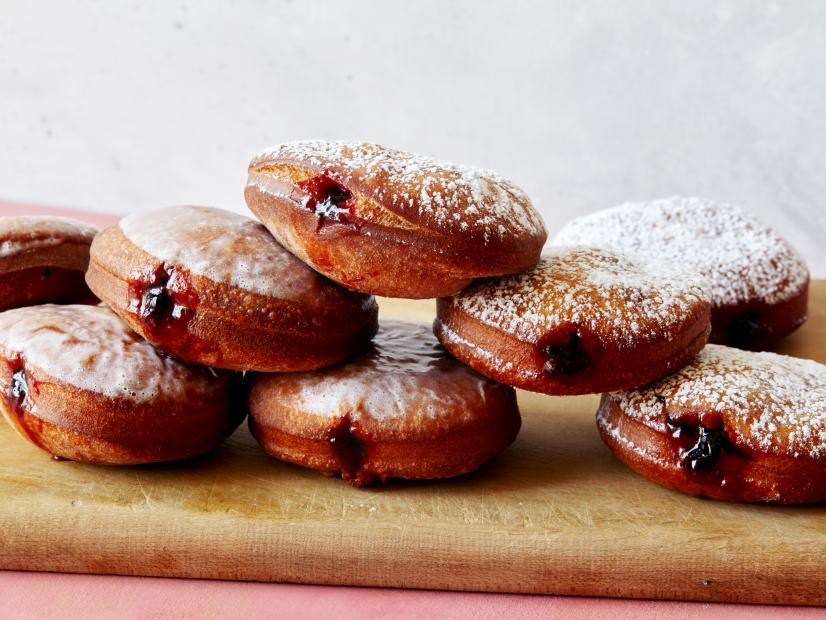
Recipe courtesy of
Michelle N. Warner
for
Food Network Kitchen
Recipe courtesy of
Michelle N. Warner
for
Food Network Kitchen
Watch how to make this recipe.
Paczki
Getting reviews...
- Level: Intermediate
- Total: 2 hr 40 min (includes rising and blooming times)
- Active: 1 hr
- Yield: 15 doughnuts
-
- Nutritional Analysis
- Per Serving
- Serving Size
- 1 of 15 servings
- Calories
- 325
- Total Fat
- 17 g
- Saturated Fat
- 3 g
- Carbohydrates
- 38 g
- Dietary Fiber
- 1 g
- Sugar
- 12 g
- Protein
- 5 g
- Cholesterol
- 35 mg
- Sodium
- 96 mg
Paczki (pronounced puun-ch-key) are supercharged jelly doughnuts, made with both whole eggs and yolks for a rich, almost savory dough, with a sweet glaze on top. Though typically enjoyed on Fat Thursday in Poland (the Thursday before Ash Wednesday), in Polish neighborhoods in the US, paczki are enjoyed as part of the Fat Tuesday celebration. The tradition started as a festive way to use up eggs, butter and lard before Lent. Though typically fried in lard, we’re frying these in vegetable oil, which is a little more accessible. Either way, some say that starting the Lenten season by eating these sweet rich treats will bring good luck and happiness throughout the year.
- Level: Intermediate
- Total: 2 hr 40 min (includes rising and blooming times)
- Active: 1 hr
- Yield: 15 doughnuts
-
- Nutritional Analysis
- Per Serving
- Serving Size
- 1 of 15 servings
- Calories
- 325
- Total Fat
- 17 g
- Saturated Fat
- 3 g
- Carbohydrates
- 38 g
- Dietary Fiber
- 1 g
- Sugar
- 12 g
- Protein
- 5 g
- Cholesterol
- 35 mg
- Sodium
- 96 mg
Ingredients
Paczki:
Filling and Glaze:
Directions
- For the paczki: Whisk together the flour and salt in a medium bowl and set aside.
- Microwave the milk in a small microwave-safe bowl until warm (between 110 to 115 degrees F.), about 1 minute, then stir to even out the temperature. Add the yeast and 1 teaspoon of the granulated sugar, stirring just enough to hydrate the yeast. Let bloom for 8 to 10 minutes.
- Meanwhile, add the butter and remaining granulated sugar to the bowl of a stand mixer fitted with a paddle attachment. Cream together on medium high-speed, stopping and scraping the bowl once or twice as necessary, until light and fluffy, about 4 minutes. Add the whole eggs and beat on medium high to combine, about 1 minute. Add the egg yolks and vanilla and beat together another minute.
- Starting with the mixer on low and then raising to medium high, add the flour mixture in 2 parts, alternating with the yeast mixture. Once the last addition of flour has been combined, knead the dough in the mixer until smooth, 6 to 8 minutes. The dough will be slack and sticking to the sides but not too sticky to the touch. If it is too sticky, add 2 to 3 tablespoons of flour and knead a minute more to tighten it up.
- Put the dough on a flour-dusted surface and knead by hand a few times, tucking the dough under itself to form a smooth ball. Transfer to a large, greased bowl, cover with a kitchen towel and leave to rise in a warm place until doubled in size, 40 to 60 minutes.
- Turn the dough out onto a floured surface and roll or pat down to 1/2 inch thick. Cut the dough into 3-inch circles and place on a lightly floured baking sheet. Make one more circle from the dough scraps or make mini paczki to fry. Cover the dough circles with a kitchen towel and let rise until doubled in size, about 30 minutes.
- Meanwhile, heat the oil in a deep Dutch oven to 350 degrees F; line a baking sheet with paper towels.
- Shake off any flour from the dough circles and fry in batches of 3 to 4 until deep golden brown, 1 to 1 1/2 minutes on each side. You will be able to tell they are cooked through because the amount of bubbles will reduce to almost nothing. Transfer the doughnuts to the paper towel-lined baking sheet as they come out of the oil. Return the oil to 350 degrees F between batches. Let rest until cool enough to handle.
- For the filling and glaze. Fit a pastry bag with a small round tip and fill with the jam. Set aside.
- Use a thick skewer or chopstick to poke a hole in the middle of each doughnut and wiggle a little space, taking care to not poke all the way through. Fill with the jam using the pastry bag.
- To make the glaze, add the confectioners' sugar to a small bowl big enough to dip a doughnut into. Whisk in the milk until smooth. The glaze should be a little loose, close to the consistency of maple syrup. Dip each doughnut in the glaze, letting it roll off a bit before turning it over to set. Some of the glaze will run down the sides which is okay, but if you need to adjust the thickness, add a little more confectioners' sugar or milk depending on what you need. Let the glaze set for about 5 minutes! If you want to skip the glaze, just dust with confectioners' sugar; many paczki are enjoyed this way too. Paczki are best the day they are made, but they can be stored in an airtight container to enjoy the next day.
Cook’s Note
When measuring flour, we spoon it into a dry measuring cup and level off excess. (Scooping directly from the bag compacts the flour, resulting in dry baked goods.)






























